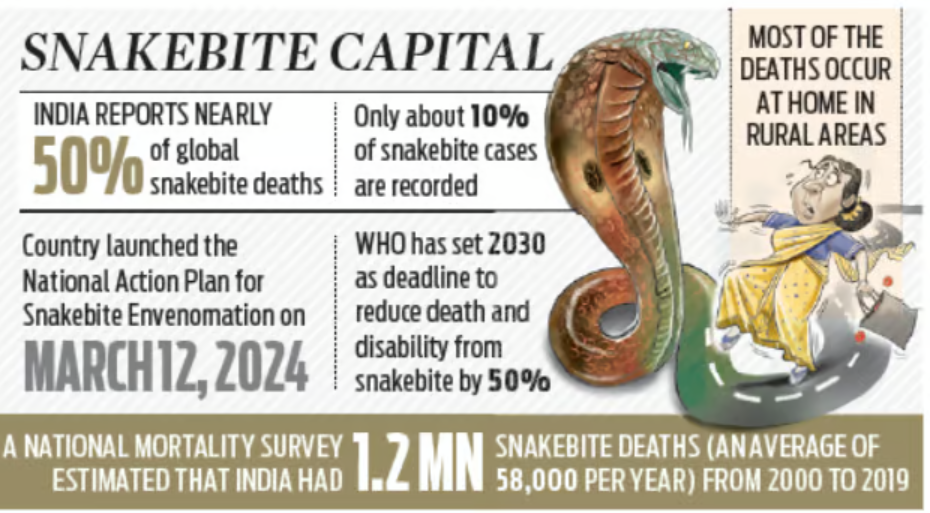Centre Urges States to Make Snakebites a Notifiable Disease to Strengthen Surveillance and Reduce Fatalities
(Source: Indian Express; Section: Cover Page; Page: 17)
| Topic: GS3 – Science and technology |
| Context: |
|
Analysis of News:

Snakebites: A Public Health Challenge
- Snakebites are a major public health concern in India, with 3–4 million cases annually and an estimated 58,000 deaths according to the 2020 Indian Million Death Study.
- This burden underscores the need for a comprehensive strategy to mitigate snakebite-related fatalities and complications.
- The Union Health Ministry has urged states to make snakebites notifiable, requiring all cases to be reported by private and public hospitals.
Notifiable Diseases
- Notifiable diseases are those that require mandatory reporting due to their potential for outbreaks, mortality, or the need for swift public health responses.
- Common notifiable diseases in India include tuberculosis, malaria, dengue, and HIV.
- Snakebites, though not infectious, qualify due to their acute medical emergencies requiring immediate treatment with antivenom to prevent fatal complications such as paralysis, hemorrhage, or organ damage.
Geographic and Species-Specific Risks
- India is home to over 310 snake species, of which 23 are medically significant. The “Big Four” snakes—Indian cobra, common krait, Russell’s viper, and saw-scaled viper—account for 90% of fatal snakebites.
- Most snakebites occur in low-altitude, densely populated agricultural regions of states like Bihar, Jharkhand, Madhya Pradesh, and Odisha.
Challenges in Managing Snakebites
- Access to Treatment: Victims often rely on faith healers or fail to reach healthcare centers on time, leading to avoidable fatalities.
- Antivenom Limitations: Commercial antivenom is region-specific, with varying effectiveness due to differences in venom composition by geography and snake age. Antivenoms also cause adverse reactions and fail to neutralize venom from certain local species like the banded krait and green pit viper.
- Venom Collection: Venom used for antivenoms is sourced mainly from snakes caught by the Irula tribe, posing logistical and ecological challenges under wildlife protection laws.
Government Initiative: NAPSE
- The National Action Plan for Prevention and Control of Snakebite Envenoming (NAPSE) aims to halve snakebite deaths by 2030.
- It emphasizes making snakebites notifiable to strengthen surveillance, identify high-risk areas, and improve clinical management.
Way Forward
- Enhanced Surveillance: Mandatory reporting can help gauge the true burden of snakebites and identify at-risk regions.
- Improved Antivenom Development: Setting up zonal venom banks and developing synthetic antibodies or peptides could address geographical and species-specific venom variations.
- Community Awareness and Training: Educating communities and training healthcare workers can ensure timely and effective treatment.
Making snakebites notifiable is a critical step toward reducing mortality and improving public health outcomes in vulnerable regions.
| Advantages of notifiable disease |
|
| Practice Question: Discuss the significance of making snakebites a notifiable disease in India. Highlight the challenges in managing snakebite cases and suggest measures to reduce fatalities and improve treatment outcomes. (250 words/15 m) |
